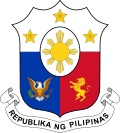| Location | Region
(regional designation) | PSGC [41] | Island
group | Regional
center | Component local
government units | Area [a] | Population
(2020) [45] | Density |
|---|
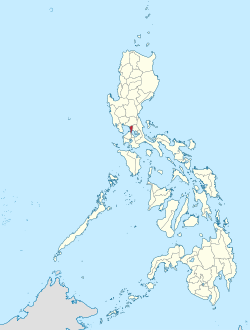 | National Capital Region
(NCR) | 13 | Luzon | Manila | | 636.00 km2
(245.56 sq mi) | 13,484,462
(12.41%) | 20,247/km2 (52,440/sq mi) |
|---|
 | Cordillera Administrative Region
(CAR) | 14 | Luzon | Baguio | | 19,422.03 km2
(7,498.89 sq mi) | 1,791,121
(1.65%) | 89/km2 (230/sq mi) |
|---|
 | Ilocos Region
(Region I) | 01 | Luzon | San Fernando | | 13,012.60 km2
(5,024.19 sq mi) | 5,292,297
(4.87%) | 386/km2 (1,000/sq mi) |
|---|
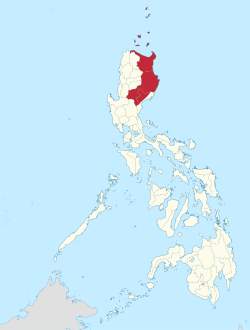 | Cagayan Valley
(Region II) | 02 | Luzon | Tuguegarao | | 28,228.83 km2
(10,899.21 sq mi) | 3,679,748
(3.39%) | 122/km2 (317/sq mi) |
|---|
 | Central Luzon
(Region III) | 03 | Luzon | San Fernando | | 22,014.63 km2
(8,499.90 sq mi) | 12,387,811
(11.40%) | 510/km2 (1,320/sq mi) |
|---|
 | Calabarzon
(Region IV-A) | 04 | Luzon | Calamba | | 16,873.31 km2
(6,514.82 sq mi) | 16,139,770
(14.85%) | 854/km2 (2,213/sq mi) |
|---|
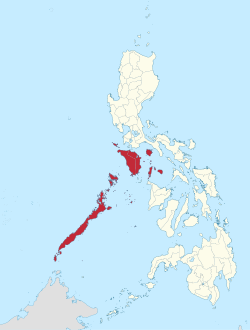 | Southwestern Tagalog Region
(Mimaropa) [d] | 17 | Luzon | Calapan | | 29,620.90 km2
(11,436.69 sq mi) | 3,212,287
(2.96%) | 100/km2 (259/sq mi) |
|---|
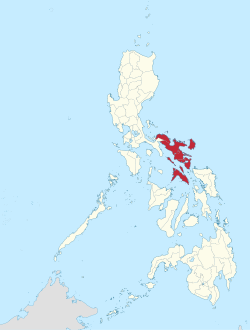 | Bicol Region
(Region V) | 05 | Luzon | Legazpi | | 18,155.82 km2
(7,010.00 sq mi) | 6,067,290
(5.58%) | 319/km2 (827/sq mi) |
|---|
 | Western Visayas
(Region VI) | 06 | Visayas | Iloilo City | | 12,750.63 km2
(4,923.05 sq mi) | 4,730,771
(4.35%) | 371/km2 (961/sq mi) |
|---|
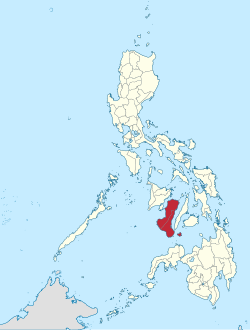 | Negros Island Region
(NIR) | 18 | Visayas | Bacolod and Dumaguete
(interim/de facto) | | 13,525.56 km2
(5,222.25 sq mi) | 4,760,340
(4.38%) | 352/km2 (912/sq mi) |
|---|
 | Central Visayas
(Region VII) | 07 | Visayas | Cebu City | | 10,114.52 km2
(3,905.24 sq mi) | 6,545,603
(6.02%) | 647/km2 (1,676/sq mi) |
|---|
 | Eastern Visayas
(Region VIII) | 08 | Visayas | Tacloban | | 23,251.10 km2
(8,977.30 sq mi) | 4,531,512
(4.17%) | 191/km2 (495/sq mi) |
|---|
 | Zamboanga Peninsula
(Region IX) | 09 | Mindanao | Pagadian | | 17,056.73 km2
(6,585.64 sq mi) | 3,862,588
(3.55%) | 213/km2 (551/sq mi) |
|---|
 | Northern Mindanao
(Region X) | 10 | Mindanao | Cagayan de Oro | | 20,496.02 km2
(7,913.56 sq mi) | 5,007,798
(4.61%) | 229/km2 (593/sq mi) |
|---|
 | Davao Region
(Region XI) | 11 | Mindanao | Davao City | | 20,357.42 km2
(7,860.04 sq mi) | 5,223,802
(4.81%) | 245/km2 (634/sq mi) |
|---|
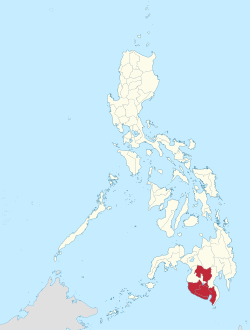 | Soccsksargen
(Region XII) | 12 | Mindanao | Koronadal | | 22,513.30 km2
(8,692.43 sq mi) | 4,351,773
(4.0%) | 202/km2 (523/sq mi) |
|---|
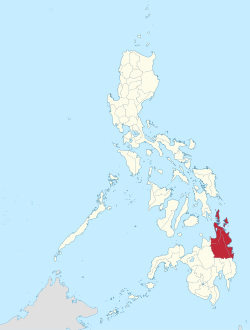 | Caraga
(Region XIII) | 16 | Mindanao | Butuan | | 21,478.35 km2
(8,292.84 sq mi) | 2,795,340
(2.57%) | 121/km2 (313/sq mi) |
|---|
 | Bangsamoro
(BARMM) [g] | 19 | Mindanao | Cotabato City | | 11,935.7 km2
(4,608.4 sq mi) | 3,944,692
(3.63%) | 330/km2 (856/sq mi) |
|---|
Notes
- ↑ Land area figures are the sum of each region's component provinces and independent cities, derived from the National Statistical Coordination Board (Philippine Statistics Authority) official website. For the BARMM, land area is derived from the Bangsamoro Development Plan Integrative Report. [42] [43] [44]
- 1 2 3 4 5 6 7 8 9 10 11 12 13 14 15 16 17 A highly urbanized city, independent from any province.
- 1 2 3 4 5 An independent component city, not under the jurisdiction of any provincial government.
- ↑ Formerly designated as Region IV-B until 2016.
- ↑ A component city, part of the province of Basilan, but whose regional services are provided by the offices of Region IX.
- 1 2 The province of Cotabato, which is part of the Soccsksargen region, has 63 of its barangays included in the BARMM.
- ↑ Following the Bangsamoro autonomy plebiscite and the ratification of the Bangsamoro Organic Law, the Autonomous Region in Muslim Mindanao (ARMM) was superseded by the Bangsamoro Autonomous Region in Muslim Mindanao (BARMM) in February 2019, which transferred the provinces and cities already in the ARMM, as well as surrounding communities that voted for inclusion.
|

